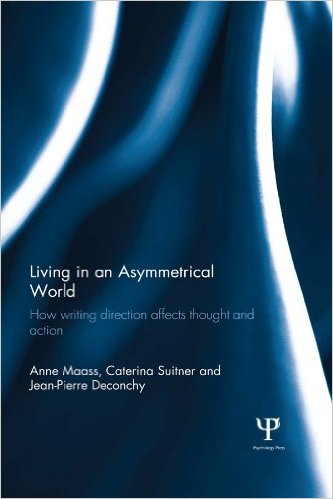Publications by members
04.07.2016, by Sibylle Classen in publication
Living in an Asymmetrical World: How writing direction affects thought and action
by Anne Maass, Caterina Suitner, Jean-Pierre Deconchy

Publisher and product details:
• Format: Hardcover and Kindl
• Series: Routledge Monographs in Behavioural Science
• Hardcover: 170 pages
• Publisher: Psychology Press; 1 edition (April 10, 2014)
• Language: English
• ISBN-10: 041552198X
• ISBN-13: 978-0415521987
Description: This somewhat unusual book approaches a contemporary topic of research from a historical perspective, reporting unpublished research conducted in the fifties in Lebanon by Jean-Pierre Deconchy, in combination with recent research on the same topic. Over the last few years, a lively research area has developed, focusing on the way in which script direction pervades different areas of cognition and social cognition. For instance, people who write from left to right tend to congruently envisage time to evolve toward right, they imagine human action to take place with a rightward direction, they tend to explore artwork in a left-to-right fashion, and they perceive motion as faster when objects move from left to right. Opposite preferences emerge for those whose language is written from right to left, such as Arabic, Hebrew and Urdu. Thus, script direction seems to produce a pervasive scheme for attention orientation and action representation. Living in an Asymmetrical World bridges five decades of research on horizontal bias by examining Jean-Pierre Deconchy’s early, previously unpublished work is examined in the light of current theory.
The book will be of interest to academics and researchers in the areas of social, cognitive and cultural psychology.
Contents: The present book is organized in 5 chapters. Chapters 1 through 3 report Deconchy’s original Thesis whereas the last two chapters create a bridge to current theorizing on spatial asymmetries and draws more general inferences about changes in research practice illustrated by the comparison between Deconchy' s work and current research.